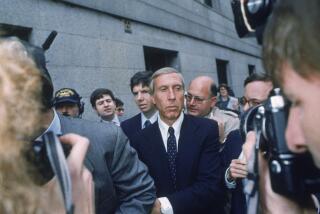Ex-Banker Exchanges Suites for a Cell
MIAMI — Once he ate from Limoges china, sipped his wine from Baccarat crystal goblets, imported five French chefs for a private dinner party and hosted Elizabeth Taylor on his $7-million yacht. He founded a world-class symphony orchestra, donated millions to charity and elbowed his way into Miami’s elite circle of power brokers.
From atop a gleaming 47-story office building designed by architect I. M. Pei--in a suite where the plumbing fixtures were gold-plated and the paintings on the walls were Old Masters--he presided over CenTrust Savings Bank and its $11-billion empire.
Today the CenTrust Tower still looms over the city, less an office building than a monument to excess. And David L. Paul stands indicted on charges of fraud and is finishing up his first week in a federal prison. He wears the standard-issue khaki uniform and is permitted to have no more than $15 in his pocket.
“He’s treated no differently here than anyone else,” said Lena Montgomery, a spokeswoman for the Metropolitan Correctional Center.
The fall of Paul in savings and loan circles is perhaps only second to that of Charles H. Keating Jr., whose failed Lincoln Savings & Loan is the largest thrift collapse ever. But even Keating, who has become a national symbol of greed and arrogance, was no match to Paul in high living and extravagance.
On Friday, a federal grand jury in Miami indicted Paul on charges of conspiracy and fraud related to the sale of $25 million worth of securities to the Bank of Credit & Commerce International. Earlier in the week, Paul was ordered to jail after a federal judge found him in contempt of court for refusing to turn over documents to a grand jury looking into the thrift’s spectacular $1.7-billion failure in February, 1990. He could serve up to 18 months.
His attorney, Aubrey B. Harwell, Jr., calls Paul “the OTS poster boy of the year,” referring to the U.S. Office of Thrift Supervision, which is seeking more than $30 million in restitution from Paul. Harwell insists that his client is being hounded by government investigators who have made him a scapegoat for a nationwide S&L; debacle, which may eventually cost taxpayers more than $400 billion.
“He is very, very much attempting to exercise his constitutional rights,” Harwell said. “But this is not just a protest in a public forum. He is a man of deep convictions.”
Paul, 52, chose to go to jail rather than hand over CenTrust documents, claiming that to do so would violate his Fifth Amendment rights against self-incrimination. Besides, Paul added, the materials sought by the grand jury are already in the hands of the Resolution Trust Corp., which is now in charge of CenTrust.
Although he has declined to talk about the specifics of the bank’s collapse, Paul has maintained that he is innocent of wrongdoing.
He has also lamented his diminished circumstances. In the past two years, he has lost his waterfront Miami mansion and his house in Connecticut. The yacht is gone, as is his 40-foot sailboat, Bodacious. The government long ago auctioned off his Tiffany ashtrays and silver serving platters. More recently, his wife has had to sell her jewelry, everything but her engagement ring.
“I need help,” Paul told the Miami Herald last year. “I just don’t know what to do. I’m desperate.”
Paul’s jailing and indictment here this week could be a portent of the future. In addition to facing about 20 civil suits resulting from the bank failure, Paul is also the target of two criminal probes.
Federal regulators already have charged in civil suits that Paul and CenTrust “engaged in regulatory violations and unsafe or unsound practices” that had led to the squandering of up to $30 million in assets. Paul has denied the charges.
Harwell, Paul’s attorney, likes to point out that “while (Paul) is not popular with the government, there are no allegations about insider loans” or other fraudulent dealings similar to those made against other high-profile players in financial scandals.
In the highflying era of junk bond financing, Paul played the role of Gatsby. He arrived in Miami in 1982, when he bought Dade Savings, a troubled S&L; that was losing $4 million a month. But he soon began to turn the thrift around, and as CenTrust’s assets grew, so too did Paul’s ambitions. By donating freely to charities, hosting galas and promoting Miami’s New World Symphony, he joined the city’s most influential business and social clubs.
He spent lavishly on art, buying works by Flemish master Peter Paul Rubens, for example, and filling the sky lobby of the CenTrust Tower with expensive sculpture. He bought stretch Mercedes limousines, traveled to health spas and, during one month in 1988, ran up a New York hotel tab of $45,000.
Over the six years of his CenTrust chairmanship, he also paid himself more than $16 million in salary and bonuses.
The first cracks in Paul’s high-rise tower of power began to appear early in 1988. A Miami business daily reported that Paul had embellished his official CenTrust biography, reporting, for example, that he had a Ph.D. from Harvard and an MBA from Columbia when he did not.
Later that year, the bank reported a $3.5-million quarterly loss; by December, the losses had climbed to $10 million.
With the hemorrhaging begun, state and federal regulators moved in. As Paul began to sell chunks of his junk bond portfolio, Florida Comptroller Gerald Lewis announced that Paul had used CenTrust as “a personal piggy bank,” spending $45 million of depositors’ money on himself.
About four months after he was ousted, CenTrust’s branches were sold to California’s Great Western Bank for $86 million.
More to Read
Sign up for Essential California
The most important California stories and recommendations in your inbox every morning.
You may occasionally receive promotional content from the Los Angeles Times.










